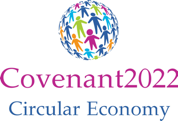SUSTAINABLE INNOVATION 2016
‘Circular Economy’ Innovation & Design
Part of the ‘Towards Sustainable Product Design’ series of conferences
21st International Conference
7th-8th November 2016
University for the Creative Arts
Epsom
Surrey
KT18 5BE
UK
The Centre for Sustainable Design ® at UCA, UK
VENUE PARTNERUniversity for the Creative Arts
STRATEGIC PARTNERSThe Knowledge Transfer Network
All-Party Parliamentary Sustainable Resource Group
Sustainable Innovation 2016: Key Lessons
Circular Economy Innovation & Design
Professor Martin Charter, Director, The Centre for Sustainable Design ® @ UCA,UK
- Context: there is a need to consider the ‘big picture’ when thinking about CE (circular economy). CE has emerged from longstanding discussions over resource efficiency and resource productivity. CE is not explicitly highlighted in the United Nations Sustainable Development goals but is relevant to a number of the seventeen goals. There needs to be more robust thinking on the relationship between CE, carbon and climate change. CE should be thought of as part of an organisation’s broader sustainability approach but is not a ‘magic bullet’. However, there are some emerging ‘schools of thought’ that belief CE is a fundamentally different model and approach that might replace sustainable development.
- Systems: systemic thinking is fundamental to CE. A mechanism to interpret CE is to think about the different types of materials (or nutrients) used within product-service-systems e.g. biological systems and technical systems. The goal being to maximise the use of renewable materials (e.g. natural fibres) within biological systems and to extend the life of non-renewable materials (e.g. plastics and metals) within technical systems. However in some product areas there is a cross-over between both systems. For example, in clothing, the mixing of biological and technical materials (or nutrients) in individual products needs to carefully thought about at the design stage to enable disassembly and separation of fibres at ‘end of (1st) life’ to enable product life extension.
- Language: the terminology used around CE can be fluid and sometimes confusing outside of specialist networks. For example, there are differences between repair, refurbishment, remanufacturing and recycling in terms of focus, scale and complexity. However, sometimes terms are used interchangeably e.g. a refurbisher of white goods described his business as being in recycling (see proposed terms and definitions within BS8001 Draft for Publication) [1].
- Policy: there needs to be smart policy development covering both demand and supply side issues associated with CE. Various instruments are available to policy-makers to stimulate circularity e.g. Sweden has offered tax breaks to increase repair levels in 2016 [2].The combination and sequence of the implementation of policy tools needs to be carefully considered and there is a need to think medium to long-term to predict and avoid unintended consequences. There needs to be further thought about what can be done and what can’t be done at international, national, regional and local levels. Lessons for CE policy development can be drawn from the European Commission’s Integrated Product Policy (IPP), a holistic approach aimed at greening markets/product that emerged in the late 90s.[3].
- Business models: business models are “all organisation” approaches aimed at delivering (more) value to customers and are an important part of the CE discussion. However, many organisations will see no need to consider CE in relation to their existing business models and may specifically focus on products and/or processes. Large and complex organisations may decide to re-engineer or optimise existing business models unless they are responding to significant opportunities and/or threats. Disruptive new business models driven by CE are more likely to come from start-ups and SMEs e.g. Bureo [4], I-Fixit [5]. Some existing incumbents may see these disruptive innovators as a threat to the ‘established order’ with others seeing opportunities for collaboration e.g. HP are now working with I-Fixit.
- Infrastructure: to move towards CE, appropriate infrastructure needs to be developed and this will require investment. A key issue is the relationship between private and public sector in developing the structures and systems to enable CE. What needs to be done to retrofit existing infrastructure and develop (and expand) infrastructure to enable circularity? Much will depend on the companies’ priorities and focus e.g. recycling factories implemented in the Japanese electronics sector [6] are different from remanufacturing factories that are run by Xerox and Caterpillar. [7] At a company level developing take-back and reverse logistics systems or reverse supply networks (either legislative driven or voluntary) to capture products (and the materials within them) is essential.
- Technology: a number of leading companies have now developed hierarchies of circularity e.g. Philips [8] and HP [9] . New technologies need to be developed to address circularity hierarchies and a growing issue will be whether circularity is open or closed due to data security and/or human contact issues e.g. Apple’s Liam I-Phone disassembly robot [10] is organised within Apple’s network whereas Veolia uses robots to disassemble various brands of television [11] within their facilities. 3D printing is creating opportunities to: produce products using filaments from recycled polymers and/or bio-polymers; and also to print components using open-sourced designs to enable repair and product life extension. In addition, there is the emergence of new DIY machines that enable the production of products that use waste plastics as feedstock. For example, the Dutch designer, Dave Hakken’s Precious Plastic [12] blueprint of open-sourced machines.
- Materials: there is an emerging discussion over the legacy of materials that may come back through increased circularity. For example, older steels may be less strong than today and older plastics may off-gas chemicals. Materials scientists and chemical engineers have a role in developing new smart(er) materials that can be un-zipped, easier to separate and are more recyclable. For example, Aquafil have developed a process that de-polymerises and re-polymerises nylon, into a 2nd life nylon – Econyl – with the same properties as the 1st life. There appears to be trust issues associated with existing and new materials and an emerging discussion over a potential need for materials passports and better information systems.
- ‘End of Life’: Original Equipment Manufacturers (OEM) that sell product’s business-to-business (B2B) through distribution channels generally do not know their final customer(s) or what happens to their product at the ‘end of life’. What are the opportunities to develop more direct customer engagement prior to the ‘end of life’ e.g. adding repair as part of customer service? What sort of incentives could be put in place to get products (and the materials within them) back to the OEM even if they are sold B2B through distribution channels. Bureo offer a free replacement service for broken skateboards e.g. new products are supplied at no charge to replace broken products.
- Consumers: There needs to be more engagement in CE amongst consumers and users of products (and the materials within them). Most consumers and users will not recognise the term CE, however, they will recognise terms like waste, repair, etc. There are emerging issues related to the need for awareness raising and behavioural change. The authenticity, transparency and provenance of data and information related to materials is under increasing scrutiny. There are growing trust issues amongst consumers associated with brand claims and the need for improved product-related environmental information e.g. labelling, on-line information, etc.
- Implementation: CE implementation poses a range of technical and people-oriented challenges. Technical challenges include engineering, chemistry and material science issues related to, for example, the de- and re-assembly of products and de- and re-polymerisation of plastics. People challenges include softer aspects e.g. awareness, (re)education, (re)skilling, etc. A key issue for many organisations is where and how to start to engage in the CE discussion e.g. some may use pilot projects to learn lessons and may focus on product(s), process(es) and/or existing or new business model(s). At an organisational level it is essential to gain buy-in and there is a need to develop and build a common vision of CE with both internal and external stakeholder engagement.
- Future: there is a need to learn from Japanese and German approaches to circularity that started in the early 90s and Chinese approaches that have emerged in the 00s. Common visions of CE need to be developed through engaging policy makers, business and civil society – which means that new stakeholder platforms need to be created at international, national, regional and local levels. Cities will pay a key role in CE due to geographical proximity to stakeholders in the innovation system. In a smarter and more connected world, there is a need for better understanding of the potential relationship between CE and the implementation of Cyber-Physical-Systems (CPS) within Industry 4.0 strategies. In parallel, there is need to identify if decentralised bottom-up grassroots innovation driven by a new movement of ‘makers, modifiers and fixers’ will deliver a more circular and low carbon future. There will be growing drive to ‘design-out’ waste, enable product life extension and move away from built-in product obsolescence.
© Martin Charter 2016 mcharter@ucreative.ac.uk
Contact
For more information on Sustainable Innovation 2016 please contact:
Professor Martin CharterDirector
The Centre for Sustainable Design ®
University for the Creative Arts
UK
Tel: + 44 (0) 1252 892772
Fax: + 44 (0) 1252 892747
Email: mcharter@ucreative.ac.uk
Website: cfsd.org.uk












